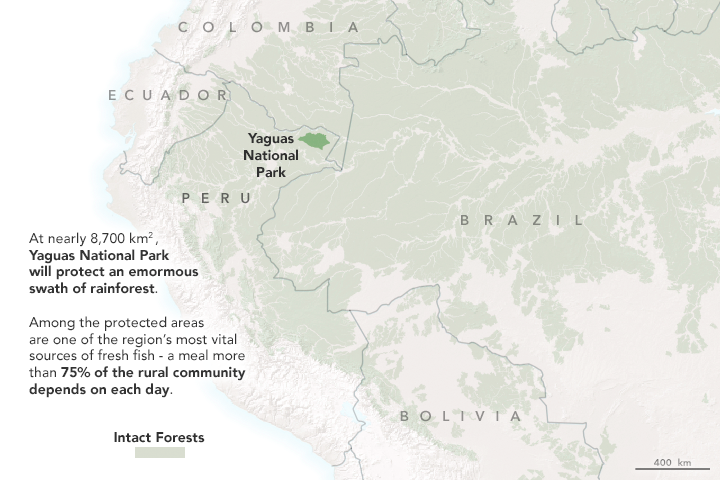



In a part of the Amazon rainforest that reaches into northeastern Peru, there are no roads cutting through the vegetation and no visible patches of deforestation. “When you see it from the air, it appears to stretch to the horizon,” said Corine Vriesendorp, a conservation ecologist at the Field Museum.
Formally established in January 2018, Yaguas National Park helped ensure that more than 2 million acres of Peruvian Amazon forest stay intact. The park’s boundaries are shown here, atop a map of aboveground forest biomass. Satellite data and models were used to estimate the density of woody material; dark green areas are denser than light green areas. The second map puts the park amidst the wider forested areas.
These intact forests are important for supporting biodiversity. They give plants and animals adequate space to maintain healthy populations and to continue to evolve as they have over millions of years. Uninterrupted or “connected” forests can even help species respond to climate change by allowing them to migrate to areas with more moisture or higher, cooler elevations.
The park does not just protect flora and fauna; it preserves an entire watershed, which Vriesendorp called “an increasingly rare conservation opportunity.” The watershed extends the entire 200 kilometers (125 miles) from the headwaters to the mouth to the Yaguas River. “That’s about the same distance as driving from Chicago, Illinois, to Madison, Wisconsin, or from New York City to Atlantic City, New Jersey,” Vriesendorp said.
Part of the Yaguas River is visible in this image, acquired on August 16, 2017, by the Operational Land Imager (OLI) on the Landsat 8 satellite. A few oxbow lakes (dark brown) are visible near the river (light brown). These bows form when the river begins to flow along an "easier" route and cuts off one of its meanders.
Abandoned meanders are likely also the reason for the light green patches that appear “bare” on either side of the Yaguas River. These are peatlands—a soil-like mixture of partly decayed plant material that can build up in the abandoned river meanders. If it becomes dried or burned, it can be a significant source of greenhouse gases such as carbon dioxide. Peatlands are extensive along the Yaguas River, and also along the larger Putumayo River to the north.
“Ten years ago, we were just beginning to realize that there were important peat deposits in the Peruvian Amazon,” Vriesendorp said. “Although there has been no comprehensive mapping of the Putumayo’s peatlands to date, it is likely that the below-ground carbon stock is immense.”
Editor’s Note: March 21 is the International Day of Forests, a day established by resolution of the United Nations General Assembly to celebrate and raise awareness of the importance of all types of forests.
NASA Earth Observatory images by Joshua Stevens, using data from Global Forest Watch, and Landsat data from the U.S. Geological Survey. Story by Kathryn Hansen.